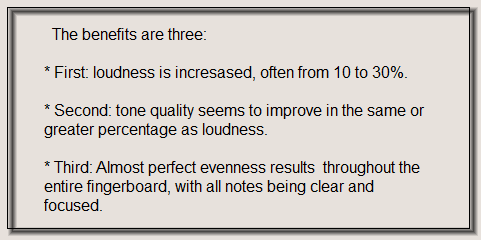Fingerboard Adjusting...the key to even note power all over the fingerboard. Page one...
by: David Langsather violin maker
3425 Fairhaven Avenue N.E.
Salem, Oregon 97301
(503) 364- 8685 PST



David at his workbench, with some of his acoustical test equipment (seen in the background).
(..'when I wore a younger man's clothes')
(Modified 12/2020;
page V_8)
...In a 'nut shell', any vibrating string interacts with its support structure (the instrument) and the effect of this support structure's interaction either enhances or detracts from the sound quality of the vibrating string.
...If the frequency of the supports at the two ends of the string differ, then the tone is adversly affected. The goal of this procedure is to ensure that the frequency at fingerboard (or nut for open sting playing) is the same, at all points, as that of the tailpiece string contact bar.
...I believe I have determined how this acoustical property of vibrating strings operates, how it can be measured and adjusted for the benefit of an individual instrument.
..The ideal frequencies for these parts are 176 HZ, 188 HZ, 198 HZ, 227 1/2 HZ or 242 HZ.
..In addition each has its preferred Wood and Rub Tones, which you use in wood selection. All parts should be at a #22 Rub Tone and all pieces on the Wood Tone Scale!
As you will see on the next pages, this adjustment involves three steps:
..
- First: Determine the current frequencies of the fingerboard and tailpiece.
..
- Second: Make the adjustments by scraping or sanding various areas of the fingerboard to 227 1/2 HZ , the tailpiece proper to 213 HZ with the string bar to 213 HZ; and finally, and nut to 227 1/2 HZ and saddle to 252 HZ.
..
* Third: Re-string the instrument, and make fine adjustments.
( Copyright 2020 (c) by David Langsather)




